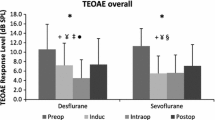Abstract
Purpose
As the middle-ear cavity is one of the noncompliant gas-filled cavities, an increase in middle-ear pressure (MEP) instead of volume expansion is observed with inhalation of nitrous oxide (N2O). Changes in MEP cause many complications, such as ear pain, temporary hearing impairment, and postoperative emesis. Therefore, we investigated changes in MEP during total intravenous anesthesia (TIVA) with propofol, fentanyl, and ketamine (PFK) and inhalation of N2O.
Methods
Twelve patients were anesthetized with PFK until 60 min after the induction of anesthesia, and then N2O (60%) inhalation was started. MEP was measured by impedance audiometry (ranging from −300 daPa to +200 daPa) at 10-min intervals during PFK, and at 2-min intervals after the inhalation of N2O.
Results
MEP gradually but significantly increased from the preanesthetic value of 16±8 to 34±12 (SEM) daPa 50 min after the induction of PFK. However, MEP did not exceed the normal limit. The values of MEP in all patients were more than 200 daPa within 36 min after the start of inhalation of N2O in oxygen.
Conclusion
PFK had a minimal effect on MEP, whereas addition of N2O to PFK increased MEP dramatically. Therefore, TIVA, or at least PFK, would be a better choice for patients with middle-ear or upper-airway diseases.
Similar content being viewed by others
References
Munson ES (1974) Transfer of nitrous oxide into body air cavities. Br J Anaesth 46:202–209
Owens WD, Gustave F, Sclaroff A (1978) Tympanic membrane rupture with nitrous oxide anesthesia. Anesth Analg 57:283–286
Perreault L, Normandin N, Plamondon L (1982) Tympanic membrane rupture after anesthesia with nitrous oxide. Anesthesiology 57:325–326
Man A, Segal S, Ezra S (1980) Ear injury caused by elevated intratympanic pressure during general anaesthesia. Acta Anaesthesiol Scand 24:224–226
Srivastava S (1980) Tympanic membrane rupture during nitrous oxide anaesthesia. Br J Anaesth 52:961
White PF (1983) Spontaneous rupture of tympanic membrane occurring in the absence of middle ear disease. Anesthesiology 59:368–369
Waun JE, Sweitzer RS Hamilton WK (1967) Effect of nitrous oxide on middle ear mechanics and hearing acuity. Anesthesiology 28:846–850
Patterson ME, Bartlett PC (1976) Hearing imparment caused by intratympanic pressure changes during general anesthesia. Laryngoscope 86:399–404
Palazzo MGA, Strunin L (1984) Anaesthesia and emesis. I: Etiology. Can Anaesth Soc J 31:178–187
Karabiyik L, Bozkirli F, Çelebi H, Göksu N (1966) Effect of nitrous oxide on middle ear pressure: a comparison between inhalational anaesthesia with nitrous oxide and TIVA. Eur J Anaesthesiol 13:27–32
Blackstock D, Gettes MA (1986) Negative pressure in the middle ear in children after nitrous oxide anaesthesia. Can Anaesth Soc J 33:32–35
Armstrong HG, Heim JW (1937) The effect of flight on the middle ear. JAMA 109:417–421
Thomsen KA, Terkildsen K, Arnfred I (1965) Middle ear pressure variations during anesthesia. Arch Otolaryngol 82:609–611
Venuti FS, Curatolo M., Chillé G, Bellinghieri F, Galletti C, Galletti B, Messina G (1991) Pressure changes in the middle ear during nitrous oxide anesthesis, Minerva Anesthesiol 57:57–62
Davis I, Moore JRM, Lahiri SK (1979) Nitrous oxide and the middle ear. Anaesthesia 34:147–151
Shinkawa H, Okitsu T, Kaneko Y (1987) Positive intratympanic pressure in the morning and its etiology (in Japanese with English abstract). Nihhon Jibiinkouka Gakkai Kaihou (J Otolaryngol Jpn) 90:695–699
Shinkawa H, Okitsu T, Yusa T, Yamamuro M, Kaneko Y (1987) Positive intratympanic pressure in the morning and its etiology. Acta Otolaryngol (Stockh) 435:107–111
Author information
Authors and Affiliations
About this article
Cite this article
Kubota, T., Hirota, K., Otomo, N. et al. Middle-ear pressure variations during total intravenous anesthesia with propofol, fentanyl, and ketamine. J Anesth 12, 17–20 (1998). https://doi.org/10.1007/BF02480760
Received:
Accepted:
Issue Date:
DOI: https://doi.org/10.1007/BF02480760




